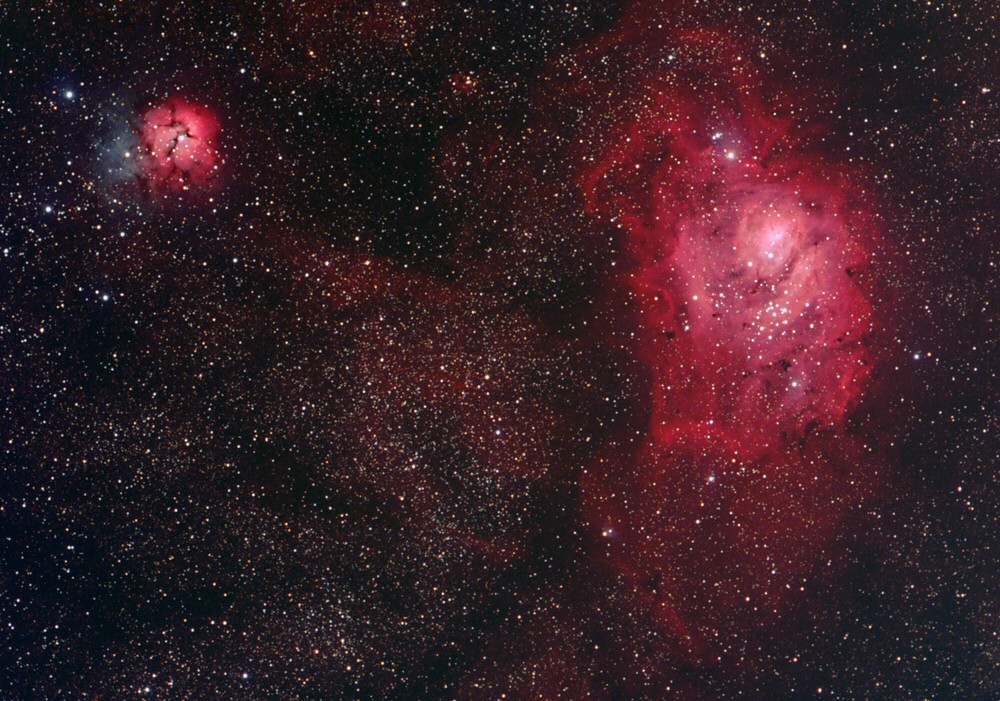
Click on the image for larger resolution (1121 x 1600 pixels)
M8 and M20 - The Lagoon and Trifid Nebulae in Sagittarius
Messier 8 is a diffuse nebula (NGC 6523) and star cluster (NGC 6530). It is one of the few nebulae easily visible to the naked eye, shining bright at 4.6 magnitude and spreading out more than 1.5 degrees across the sky (the moon is 0.5 degrees). The "Lagoon" gets its name from the dark nebular band that separates the nebula into two lobes. Messier 20, known as the Trifid Nebula due to its three part lobe shape, is also comprised of both nebulosity and a cluster. In fact, Messier himself described only the cluster portion of this object.
Location:
Texas Star Party 2004 near Fort Davis, Texas (Ha Luminance)
FWAS dark sky site near Springtown, Texas (RGB)
Seeing:
5/10 (Luminance), 5/10 (RGB)
Transparency:
8/10 (Luminance), 5/10 (RGB)
Date and Time:
May 21, 2003 (Luminance), September 11, 2004 (RGB)
Equipment:
Tak FSQ-106 @ f/5 with Tak NJP mount
Camera: SBIG STL-6303E NABG with integrated filter wheel
Exposure Info:
(Ha+R)GB
Length: Ha luminance - 35 x 1 minutes exposures (best of 55)
RGB - 40:35:30 minutes (5 minute sub-exposures unbinned)
Filter: Custom Scientific 5 nm H-alpha filter
Processing Information:
Darks, flats, deblooming, alignment, stacking, RGB combine, and digital
development in MaxIm DL 4. Curves, Levels, selective Unsharp Mask, and
Color balance in Photoshop CS.
Exposure Notes: I took the short Ha luminance shown below and blended it into the Red channel 50%. I chose this method because the length of the luminance wasn't long enough to stand on its own, which would have brought too much noise into the image.
Special thanks to the Three Rivers Foundation (3RF) for the use of some of the equipment used to create this image.

Gaz, Toz ve Yıldızlar İçerisindeki Deniz Kulağı Bulutsusu
Açıklama : Deniz Kulağı Bulutsusu'ndaki yıldızlar gaz ve toz savaşı veriyor
ama kazanan fotoğrafçılar oluyor. M8 olarak da bilinen bu fotojenik bulutsu,
Yay Takımyıldızı yönünde, dürbünsüz bile görülebilmektedir. Enerji dolu
yıldız oluşum süreçleri yalnızca renkleri değil, karmaşa da yaratmaktadır.
Kırmızı renkte ışıldayan gaz, yüksek enerjili yıldız ışıklarının
yıldızlararası hidrojen gazına çarpması sonucu ortaya çıkmaktadır. M8'i
dantel gibi kaplayan koyu renkli toz şeritleri, soğuk dev yıldızların
havakürelerinde ve üstnova patlamalarının kalıntılarında oluşmuştur. Bugün
M8'den bize gelen ışık, yaklaşık olarak 5000 yıl önce yola çıkmıştır. Işığın
M8'in bu bölgesini boydan boya geçmesi, yaklaşık olarak 50 yıl sürmektedir.
Astronomi Nebula Resimler Astrophotography Galaxy Resimler Yıldız kümeleri Resimler
Copyright(c) 2003 - 2004 - Cetinbal - All rights reserved.